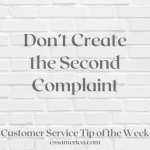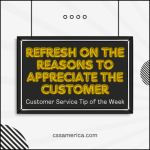I went to a restaurant called Big Ed’s (no relation) in Raleigh, NC recently. It’s basically country cooking with fantastic breakfast options! On the menu there was a quote that said:
If you enjoyed your meal, tell a friend. If not, please tell us.
That was an excellent statement that embodies a guiding principle that a lot of organizations should focus on for customer feedback.
You want the word-of-mouth advertising, so are you asking for it from your customers? Retention may be the most cost-effective marketing available, but a referral from an existing customer (i.e., asking them to tell a friend) is the second most cost-effective. It costs you nothing but the great experience that you’re hopefully already delivering…and maybe a simple request from you to the customer.
Ask the customer to tell you if they have an issue. Many customers leave businesses after a bad experience and never come back. The company may or may not know that that customer had an issue because frankly, the company doesn’t ask for feedback. And most customers don’t offer unsolicited feedback, so most negative experiences are unknown to the company. Sure, there is social media now, and people vent there, but it’s still a small percentage of the total customer base.
If you want to learn, you want to hear it from your customers directly. Therefore, you have to ask for the feedback. Never assume leaving customers are happy customers. Never assume somebody who doesn’t complain is thrilled. Never assume that if somebody has an issue, that they’ll tell you directly.
Ask the customer to share their great experiences with others, and ask them to share their concerns with you.
Signup for FREE Tips! Contact Us More Resources for You Visit Our Home Page
























